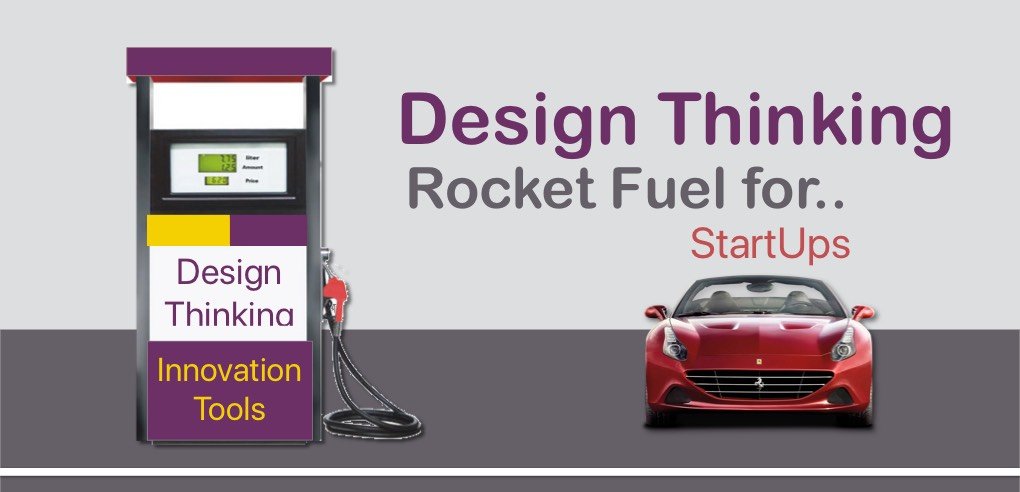2017

Design thinking Rocket Fuel for Start-ups.
Tech startups should adopt Design Thinking Mindset.
Design Thinking could help Choose the right problems to solve, Come up with solutions that will be liked, appreciated by users, and most importantly, ‘Bought’ by the customers. Yes, Design Thinking and user empathy can add a lot of real-life user context into your solutions. Startups could also explore the use of other ‘Innovation tools’ during their product development process.
Context:
Most Tech startups I have met up within the recent past, have a promising technology or innovative ideas, and of course brilliant minds behind them. Startups do fall in love with their technology or own ideas, which of course is a good sign that gives rise to great passion and huge efforts and extremely hard work.
ICT Solutions:
Information-Communication-Technology (ICT) is an immense source of energy for improving the way humans do things, at home at work, or leisure. Still, quite a few of the Tech startups I met up with had an idea based on which they built great tools using parts of the ICT available. Yes, these are great solutions for sure. Some product innovators, have a ‘feeling’ that they are building the right solution, by right, I mean, market worthy! Solutions those are great, not necessarily please the users. I think the difference is in understanding the needs rather than picking and satisfying the wants.
Design thinking methodologies help to understand the real needs of the users, pains in their daily life, with deep empathy, and more importantly, going back to the users with a quick prototype, and validating if they ‘still’ like the solution. The beauty of the process is it is relatively inexpensive, and really quick. It’s easy to Discard the ideas which are not liked, and focus on ideas, of features which users love, and customers will Pay for. Of course, easier said than done.
Classic Design Thinking methodology:
The classic Design thinking methodology process map (D-school Stanford) looks like this:
Yes its straightforward,
- Empathize with the target users, Learn about their daily life, their pain points, their dreams, and their Wants.
- Define: Then try and go beyond the wants to figure out their real needs. Define the problems or Needs in the usage and environmental context.
- Ideate: Generate ideas for the solutions to the Identified problems above, using various lateral thinking methods. Finalize your product/service Idea.
- Prototype: Quickly build a prototype of the product, service or the System that is offered by the product, completely or partially
- Test: Show your prototype (which are more like a tangible version of concept solutions or ideas, explain the benefits, and how it might work in detail, Get some feedback, and rework or freeze the solution.
Yes process wise it is not much different from most of the product designers have been doing for ages, but like they say, the God is in the details. This simple classic Design thinking process, has to be moulded, to suit the kind of problems you are solving, the configuration of participants, and available time.
It will make sense to inject other innovation tools, like Mind mapping, Enacting like users, Agile stories, Jobs to be done format of stories, (and so on..) appropriately during these 5 phases, to make the group more effective.
Design Thinking for Startups
Startups typically are trying to address problems which do not have clear solutions, or offering alternative, inexpensive, better, efficient, more immersive, simple solutions.
Resources wise, (Manpower, money, technology, machinery, most importantly TIME) most startups do not have too many. Hence if any methodology gives them Quick Solutions, conceptualized, built, tested, would be a boon. and that is exactly what Design Thinking brings on to the table.
Because amount of resources consumed are very low, group can even discard the prototype, or even the concept, and start afresh on another promising thread of the solution. Falling in love with own Idea is a typical trap, entrepreneurs might fall in, unless you get them validated with users, check if they will PAY for the idea, and yes if not, leave it and select another one.
Even large enterprises I have seen, Product managers building a huge list of features which is nothing but an intersection of all features that all of my competition has. The simple rule is empathize with your users, show them your ideas, and invest only the ones that gives you a premium over the competition, don’t just do everything that all of your competition is doing.
To summarize, Design thinking methodologies surely will prove to be the right fuel for the startups in India. Frankly why startups, most tech organizations will benefit from adopting Design thinking mindset.
